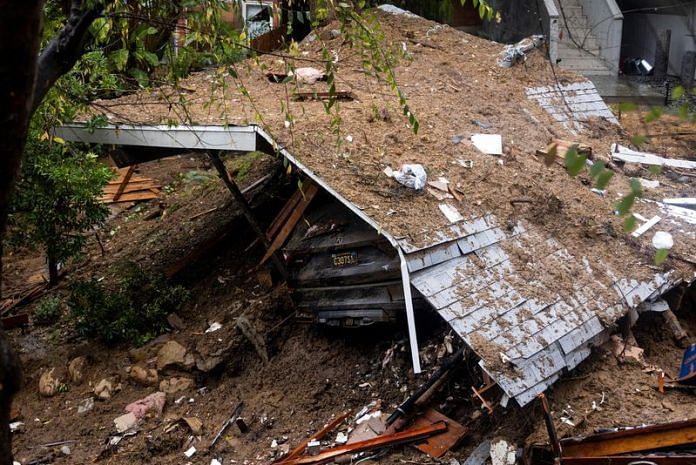By Steve Gorman and Daniel Trotta
LOS ANGELES (Reuters) -A deadly Pacific storm, the second “Pineapple Express” to sweep the West Coast in less than a week, crept over Southern California on Monday, unleashing torrential downpours that triggered street flooding and mudslides throughout the region.
Extreme-weather advisories for floods, high wind and winter storm conditions were posted on Monday across parts of California and southwestern Arizona where some 35 million people live, and authorities urged residents to limit their driving.
The National Weather Service documented staggering rainfall amounts from the storm, which lashed Northern California on Sunday with hurricane-force gusts of wind, along with heavy precipitation that intensified as the system moved south on Sunday night and Monday.
The National Weather Service (NWS) said more than 10 inches (25.4 cm) of rain had fallen since Sunday across the Los Angeles area, the nation’s second-largest city, with much more expected before showers were due to taper off later in the week.
“Significant flooding is ongoing and expected to expand,” the NWS said in a notice posted online.
The Los Angeles Police Department reported scores of traffic collisions with injuries since the storm began, many more than usual, while city Fire Chief Kristin Crowley said her crews had responded to at least 130 flooding incidents by Monday morning.
The intense rainfall, with heavy snow in high-elevation mountain areas, was carried to California by a storm system meteorologists call an atmospheric river, a vast airborne current of dense moisture funneled inland from the Pacific.
The latest tempest, and a less powerful storm that hit California on Wednesday and Thursday, also qualified as a “Pineapple Express,” a type of atmospheric river originating from the subtropical waters around Hawaii.
Winds gusting to 75 miles per hour (121 kph) on Sunday downed trees and utility lines across the San Francisco Bay Area and California’s Central Coast, knocking out power to roughly 875,000 homes at the storm’s peak in that region.
At least two people were killed by wind-toppled trees on Sunday – an 82-year-old man in the former gold rush town of Yuba City and a 45-year-old man at Boulder Creek in the coastal Santa Cruz Mountains
The greatest flash-flooding threat on Monday centered on Southern California, the NWS said, as the system slowly pivoted and pushed farther into the interior of California, but forecasters said “catastrophic” impacts were unlikely.
“There is widespread moderate flooding, but right now things seem to be somewhat manageable,” said Daniel Swain, a meteorologist and climate scientist at the University of California, Los Angeles, during a briefing on YouTube on Monday.
HILLSIDE COMMUNITIES HARDEST HIT
A number of upscale communities built on the slopes of the Hollywood Hills, Beverly Hills and Topanga Canyon were among the hardest hit by from landslides.
Beverly Hills resident Jeb Johenning, standing in a neighborhood where cars stood half buried in muck and debris, said he noticed three fissures had opened on a hillside near his home, releasing “an avalanche of mud” down the slope.
“I was driving up here last night, right after the Grammys, and coincidentally, my neighbor, who was in this SUV behind us, was being dropped off at his house, and the driver’s coming down the hill, and the mud is chasing the driver,” Johenning recalled.
Still, the overall extent of property damage in the region appeared less severe than might have been expected given record amounts of precipitation, Swain said, citing two possible reasons.
Rainfall rates were diminishing as the storm wore on, and last summer’s Southern California wildfire season was mild compared with some previous years, leaving more hillsides and canyon walls able to withstand a heavy soaking without collapse.
Flooding nevertheless posed considerable travel hazards. Rescue teams have pulled dozens of people to safety statewide, mostly motorists stranded in cars by rising waters when they tried to drive through flooded roadways, according to Brian Ferguson, spokesperson for the Governor’s Office of Emergency Services (OES).
He said evacuation orders also were in effect for several Southern California neighborhoods considered to be at particularly high risk of flash floods and mudslides.
“We’re not out of the woods yet,” Ferguson told Reuters by telephone. “There could continue be very dangerous impacts all through Southern California today and tomorrow.”
California Governor Gavin Newsom on Sunday declared a state of emergency in eight counties with a combined population of more than 20 million people.
(Reporting by Steve Gorman in Los Angeles and Daniel Trotta in Carlsbad, California; Additional reporting by Brendan O’Brien in Chicago and Julia Harte in New York City; Editing by Will Dunham, Sandra Maler and Michael Perry)
Disclaimer: This report is auto generated from the Reuters news service. ThePrint holds no responsibilty for its content.



